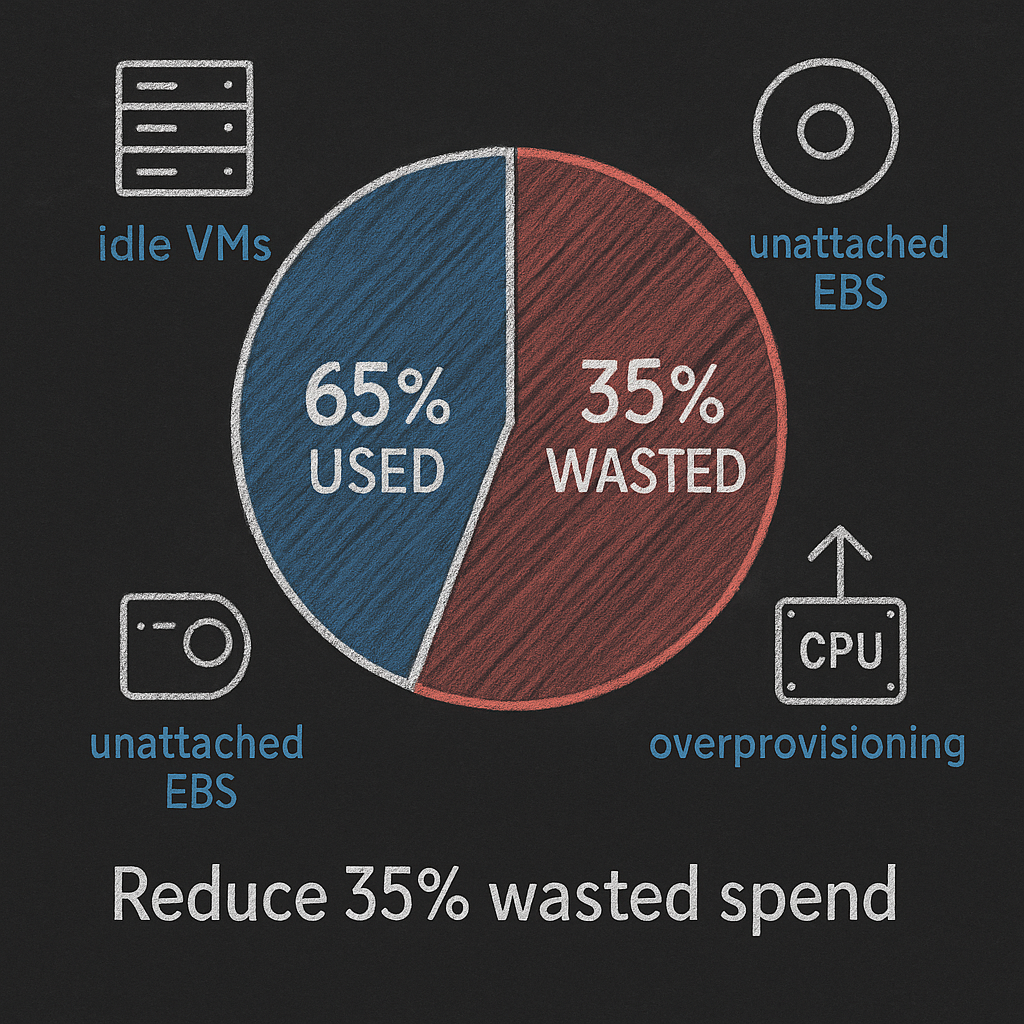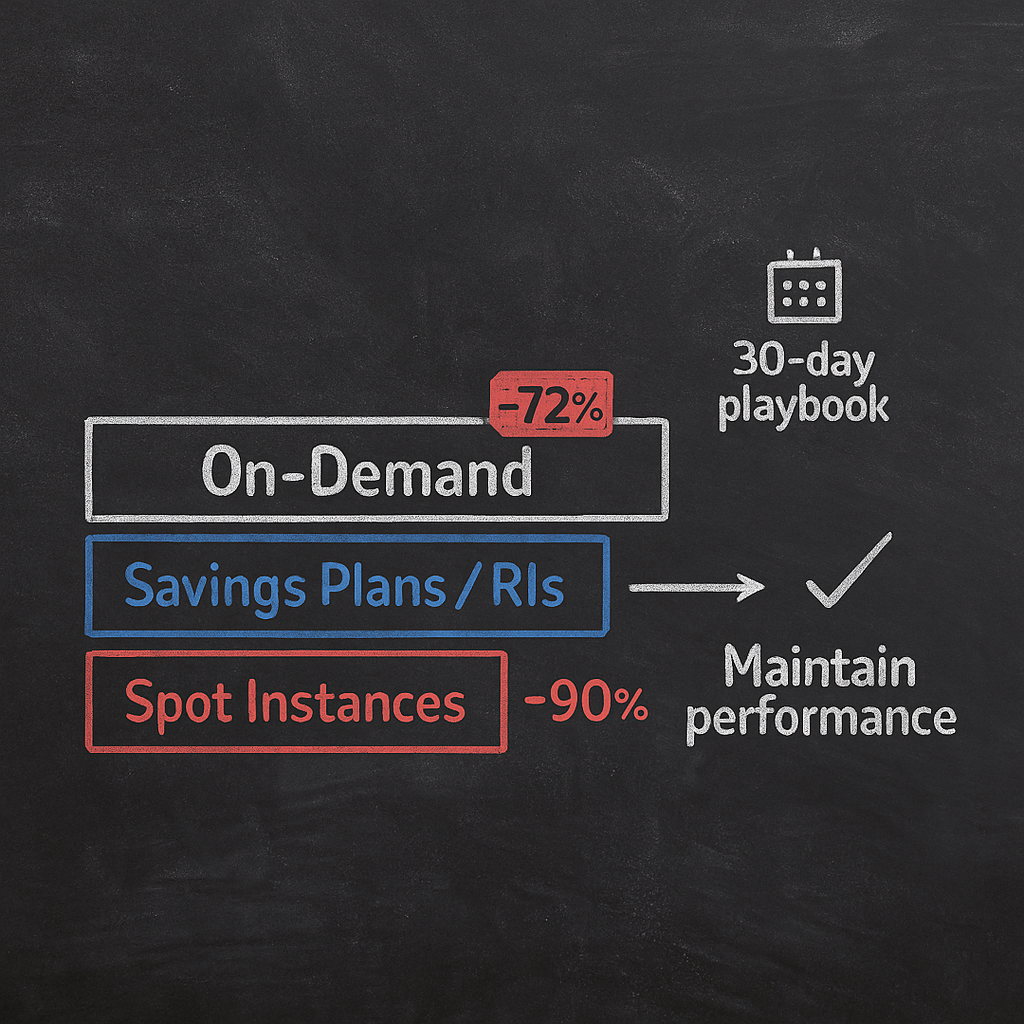Cloud rate optimization strategies to reduce AWS spend without performance loss
Paying too much for AWS? You’re not alone—and you don’t need a big engineering push to fix it. Most organizations waste 35% of their cloud spend on unused or idle resources, representing significant optimization potential.

What is cloud optimization? What is rate optimization?
Cloud optimization is the systematic process of reducing AWS expenses while maintaining or improving performance and compliance through identifying inefficiencies and leveraging AWS pricing models. It’s about getting more value from your cloud investment, not just cutting costs.
Rate optimization specifically focuses on selecting optimal pricing models (like Savings Plans and Reserved Instances) to maximize discount opportunities for predictable workloads without changing performance. While AWS offers impressive discounts—up to 72% compared to On-Demand pricing—many organizations leave this money on the table.

A practical AWS cost-control framework
Cost control isn’t a one-time effort—it’s a repeatable system you can implement monthly or run on autopilot.
Right-size compute and databases
Match instance types and sizes to actual workload requirements. Organizations typically waste 35% of their cloud spend on inefficient resource allocation and unused instances. AWS Compute Optimizer analyzes historical resource utilization and typically reveals 30-50% over-provisioning in unoptimized environments.
Rate optimization (Savings Plans and RIs)
Cover predictable workloads with Savings Plans or Reserved Instances for significant discounts. AWS offers three Savings Plan types: Compute Savings Plans (most flexible), EC2 Instance Savings Plans (instance-type specific), and Amazon SageMaker Savings Plans. Aim for 70-80% coverage for steady-state workloads.
Spot strategies for flexible workloads
Spot Instances provide access to unused EC2 capacity at up to 90% discount compared to On-Demand pricing but can be interrupted with two-minute notification. They’re ideal for fault-tolerant, flexible applications like batch processing, containerized workloads, and stateless web servers.
Storage optimization (EBS and S3)
Suboptimal storage choices like using gp2 volumes when gp3 would provide the same performance at 30% less cost contribute significantly to wasted cloud spend. Unattached EBS volumes and outdated snapshots are common sources of idle resource waste that continue to generate costs without delivering value.
For S3, implement Intelligent-Tiering to automatically move objects between frequent and infrequent access tiers, saving up to 20% on storage costs compared to manually managed tiering.
Kubernetes compute/storage tuning
Right-size node groups, enforce requests/limits ratios, implement autoscaling, and align storage classes with workload I/O requirements. Effective cloud native application monitoring is essential for identifying optimization opportunities in containerized environments.
Idle-resource cleanup
Idle resources are the “digital equivalent of servers collecting dust”—running but delivering no business value while generating ongoing costs. Industry analysis shows 35% of cloud spend is wasted on idle or underutilized resources, with orphaned EBS volumes, unattached IPs, and old snapshots being primary culprits.
Tagging and governance
Proper tagging enables accurate cost allocation across departments, projects, and environments. AWS recommends mandatory tagging policies for all resources. Service Control Policies (SCPs) can enforce tagging requirements and spending limits across organizational units, preventing uncontrolled cost growth.
Continuous automation
Automation for continuous monitoring addresses the complexity that makes manual optimization nearly impossible to sustain across dynamic cloud environments. Without automation, cost optimizations tend to erode over time as environments change.
A step-by-step AWS cost audit and remediation (30-day playbook)
Days 1–3: Establish visibility
-
Map your spend and usage
- Run AWS Cost Explorer to identify top cost drivers and spending trends across services, regions, and accounts
- Enable AWS Cost Anomaly Detection for immediate alerts on unusual spending patterns
-
Set tagging standards
- Define essential tags: owner, environment, application, cost_center
- Turn on cost allocation tags in the billing console
Days 4–10: Rightsize compute and databases
-
Pull rightsizing recommendations
- Use AWS Compute Optimizer for data-driven rightsizing suggestions
- Analyze CPU, memory, and EBS I/O patterns to identify mismatched resources
-
Apply EC2 tuning
- Downsize or change instance families where utilization metrics show opportunity
- Consider Graviton instances for compatible workloads to improve price-performance
- Reference best practices for AWS EC2 performance management
-
RDS optimization
- Right-size database instances based on actual connection counts and query patterns
- Enable Performance Insights to identify database bottlenecks
- Implement AWS RDS MySQL performance tuning best practices
Days 11–15: Optimize storage
-
EBS optimization
- Migrate gp2 volumes to gp3 for similar performance at lower cost
- Remove unattached volumes that continue to generate costs
- Implement snapshot lifecycle policies to automatically prune outdated snapshots
-
S3 optimization
- Implement S3 Lifecycle Policies to automatically transition objects to lower-cost storage classes
- Enable Intelligent-Tiering for data with variable access patterns
Days 16–20: Commit to the right rates
-
Savings Plans and Reserved Instances
- Calculate a conservative baseline from the last 30-90 days of usage
- Purchase 1-year or 3-year commitments to cover that baseline while leaving room for changes
- Learn how to implement rate and discount optimizations
-
Spot instance implementation
- Identify workloads suitable for Spot: batch processing, CI/CD pipelines, dev/test environments
- Implement graceful interruption handling for Spot workloads
Days 21–25: Kubernetes and elasticity
-
Kubernetes optimization
- Right-size node groups based on actual pod resource utilization
- Implement Horizontal Pod Autoscaler and Cluster Autoscaler for dynamic scaling
- Ensure storage classes align with application performance requirements
-
Elasticity implementation
- Schedule automatic shutdown of non-production resources during off-hours
- Implement auto-scaling groups with appropriate minimum and maximum settings
Days 26–30: Governance and verification
-
Enforce policies
- Implement tag policies and SCPs to ensure compliance with tagging standards
- Set up AWS Budgets with alerts for proactive spending management
-
Validate performance
- Confirm that optimizations haven’t impacted application performance
- Verify compliance with your AWS performance SLA
-
Establish continuous optimization
- Set up regular review cadence with finance and engineering teams
- Consider automated optimization solutions if internal resources are limited
Real-time monitoring and “autopilot” optimization
AWS native tools
- AWS Cost Explorer provides detailed visibility into current and historical spending
- AWS Compute Optimizer offers ongoing rightsizing recommendations
- CloudWatch and Container Insights establish performance baselines to prevent optimization-related regressions
- AWS Budgets alerts when spending approaches predefined thresholds
Automated optimization
Hykell’s automated AWS cloud cost management solutions can help achieve 40% savings without ongoing engineering effort by providing:
- Continuous monitoring for optimization opportunities
- Automated implementation of cost-saving measures
- Real-time cost visibility and anomaly detection
- Integration with existing governance frameworks
Metrics that matter
Track these key metrics to gauge optimization effectiveness:
- Reserved Instance and Savings Plan coverage (target: 70-80% for steady workloads)
- Idle resource percentage (target: below 10% in production)
- Average EC2 utilization rates (align with application performance requirements)
- Storage distribution across tiers (maximize cost-effective tier usage)
- Kubernetes resource efficiency (requested vs. actual utilization)
- Cost per business metric (requests, users, transactions)
Proper cloud resource utilization analysis delivers cost reduction, performance optimization, reduced environmental impact, and improved budget predictability.
Common pitfalls to avoid
- Overprovisioning resources “just to be safe,” which significantly contributes to wasted spend
- Overcommitting to Reserved Instances without accurate usage forecasting
- Ignoring storage optimization opportunities like gp2 to gp3 migrations
- Decentralized resource management without proper visibility and governance
- Prioritizing cost reduction over performance requirements
Real-world results
Mid-sized e-commerce company: 75% reduction
A mid-sized e-commerce company achieved a 75% reduction in AWS budget through systematic monitoring and resource optimization, eliminating idle instances and implementing auto-scaling. Their CIO noted: “Right-sizing wasn’t about cutting corners—it was about eliminating waste.”
SaaS provider: 38% reduction
By implementing a combination of right-sizing, Savings Plans for steady workloads, and Spot Instances for batch processing, this company reduced their AWS costs by 38% while maintaining performance SLAs.
Hykell customer results: 40% savings
Organizations implementing Hykell’s automated optimization solutions typically achieve up to 40% savings on their AWS environments while maintaining performance—all without requiring ongoing internal engineering effort.
Deepen your practice
- Fine-tune EC2 performance with AWS EC2 performance tuning guidelines
- Optimize database performance with AWS RDS MySQL performance tuning techniques
- Implement effective observability with cloud native monitoring tools
- Understand service guarantees with AWS SLA availability documentation
- Stay informed about emerging trends with cloud optimization trends insights
- If you also use Google Cloud, explore our GCP cost optimization tools
Cloud cost optimization is a continuous process—not a one-time event. To achieve sustainable savings, either implement this framework as an ongoing practice or put optimization on autopilot with specialized tools.
Ready to cut your AWS bill by up to 40% without the ongoing engineering effort? Try Hykell’s automated optimization platform. We dive deep into your cloud costs, uncover hidden savings, and optimize your infrastructure. When we’re done, you’ll save up to 40% on AWS—and we only take a slice of what you save. If you don’t save, you don’t pay. Visit Hykell to get started.
